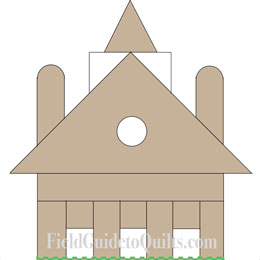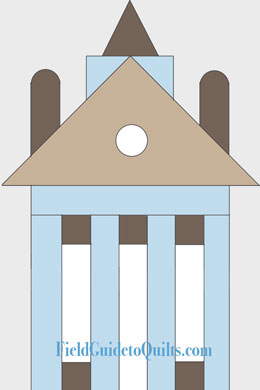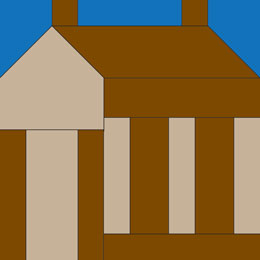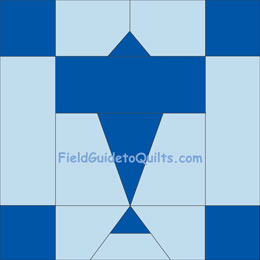| FieldGuidetoQuilts.com |
 Buildings & Travel Buildings & Travel |
Village Church
 Village Church
Village ChurchLAC
#123, 1897
 The Village Church
The Village ChurchHall, 1935
Carrie Hall was the exception. She included it in her 1935 book The Romance of the Patchwork Quilt in America, but made the design into a long tall dealie that's half again the height of the original.
The result is a building that would be at home next to a federal courthouse. But so be it: Sometimes our "village" is Washington, DC or Manhattan.
The original LAC pattern was 9x14. We traced the block for the graphic (it's almost perfect). The tiny green zigzag at the bottom was in black on the original.
Garfield's Monument
 Garfield's Monument
Garfield's Monument LAC #136, 1897
| Americans put Garfield on a pedestal. This one is in Washington, DC. |
Guiteau, under trial, claimed that it was the doctors who had murdered Garfield. "I deny the killing," he announced. "I admit the shooting."
Guiteau's poetic tribute was remembered for many decades.
1, 2, 3, 4, 5, 6, 7,
All good children go to heaven.
All bad children go below,
There to linger with Guiteau.
Garfield's tribute was forgettable. And if that weren't enough indignity, he was memorialized by the goofy quilt block at left.
The block was #136 in the Ladies Art Company's 1897 catalog. We've reversed the colors to show the seamlines.
The Old Homestead
 The Old Homestead
The Old HomesteadLAC #108, 1897
Nostalgia is not entirely a good thing. All the talk about grandmothers and the needlework with love in every stitch and the coziness of warm blah blah blah has made quilting into an archaic craft like whittling or dancing to the fiddle.
Boomers today make quilting a hobby, an obsession ("quilt pox") and a literal billion-dollar industry today. What will happen when they're gone? Perhaps we'll shake the "good old days" and let quilting have a future, too.
Meanwhile, the block at left is based on a 20x20 grid.
Dream Ship
 Dream Ship
Dream ShipCabot
Chicago Tribune, 1938 From Nancy Cabot (aka Elizabeth Leitner Rising) of the Chicago Tribune (1938).
The Air Plane
KCS, 1934
The Star made reference to an aviation block it published in 1927 (apparently The Aircraft Quilt, from 1929), saying the older block had returned, improved, to the paper ("an example of casting bread upon the waters").
The block is made so that the quilter can sew it in strips and build the block strip by strip. The progression: the upper right triangle, the propeller, the nose, the wings, the fuselage,the tail, the lower triangle. Or the other way around.
Easy peasy. And it's still a good block for a child's quilt.
Lone Eagle
 Lone Eagle
Lone EagleKCS, 1957
Quilting researcher Carrie Hall discovered this block in the 1930s and stitched up a copy, which now resides in the Spencer Museum of Art at the University of Kansas. The propeller blades on Hall's original are shaped a bit more like teardrops than in our illustration at left. The background was white, and the airplane body was a brown print.
The Aircraft Quilt
 The Aircraft Quilt
The Aircraft QuiltKCS, 1929
















The Aircraft Quilt
This 1929 Kansas City Star invention was replicated in Nancy Page's Aeroplane in 1933, and Carrie Hall included it as Airplane in her 1935 book Romance of the Patchwork Quilt in America.
The block is pictured with window sashing built in, and it's there to make the block square. The effect is to make the airplane look quite small compared with the corner squares.
We wouldn't use this block for a whole quilt, but if you wanted to, it would look like a bit like the mockup at right.
| Pieces and Patches A "patch" and a "piece" of fabric are both fabric, but since patches are used to mend clothes, quilters usually say "piece." "Pieced" and "patchwork" quilts mean the same thing too. They're pieces sewn together to make a quilt top, which is then backed with cloth and stuffed with batting. Appliqué is when quilters put one piece of fabric on top of another and stitch it down. Appliqué quilts are made of pieces too. However, goof-prone appliqué quilters may use a piece as a patch on the sly. |




